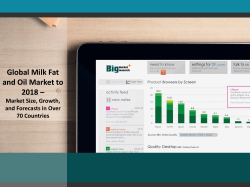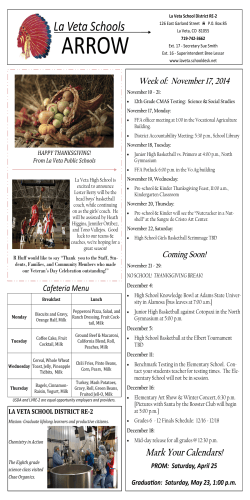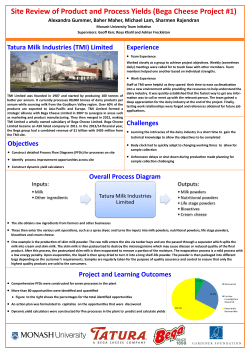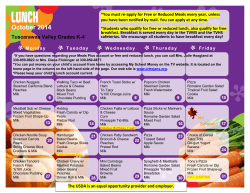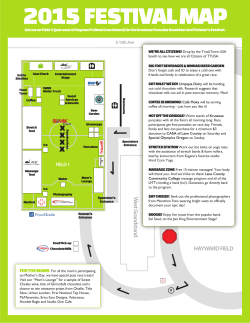
Introduction - NewTrends Publishing, Inc.
Introduction The cow is the foster Mother of the human race. From the day of the ancient Hindoo to this time have the thoughts of men turned to this kindly and beneficent creature as one of the chief forces of human life. William Dempster Hoard, 1885 In my early twenties, I moved to Martha’s Vineyard. I was suffering from severe intestinal illness but holding on to the belief that I could find my own solutions to this intractable medical problem. I started buying raw milk at Fred Fisher’s dairy farm in West Tisbury, drinking some fresh and using the rest to make yogurt or “clabbered milk.” My intestinal problems mysteriously cleared up. Several years later I went on to medical school and became a naturopathic physician. In the decades since, I’ve recommended raw milk and the foods you can make from it to most of my patients. I send them to Debra Tyler’s Local Farm in rural Connecticut because she feeds her Jerseys only grass and hay, and I’ve found that makes for the best milk. I’ve never known one of my patients to have a problem with raw whole milk from grass-fed cows, though I’ve read accounts of people who have. Over ninety-five percent of America’s dairy farmers drink their milk raw. I’ve asked a number of them why, and the answers range from, 1 The Untold Story of Milk “Tastes better” to “Makes me feel good” to “Don’t like store-bought food.” Maybe they’re on to something. Did you know that raw milk and the products made from it shaped the cultures that founded western civilization? The earliest human artifacts include vessels containing residues of milk. Where people have traveled, the ox and the milk cow have followed. Rome was built on ground blessed by libations of milk. In America, the arrival of a shipload of cows saved the Jamestown colony from starvation. Cows went west with the settlers, hitched behind wagons pulled by their brothers the oxen, feeding families and calves alike. The bovine tribes have been our best animal friends for a long, long time. Those contented cows fed on green pastures, and when the way cows were fed began to change in the 1800s, our relationship with bovines began to deteriorate. The decline began with distillery dairies and continued as cities grew. In those dairies, confined, diseased and abused cows were fed the acid waste products of the whiskey industry. The milk they produced often led to disease; the solution proposed was pasteurization. In recent years, we’ve seen the growth of modern confinement dairies, where cows never leave their stalls. Though conditions generally are not as bad as those of the distillery dairies, many of these cows are sick with mastitis and other chronic conditions. These facilities now produce something like seventy percent of our milk in the United States. Many people want an alternative to modern commercial milk, and hundreds of thousands of Americans—perhaps millions—are drinking organic milk today. And a growing number are going to great lengths to obtain raw milk from healthy cows, while many more have grown curious about raw milk and want more information. Accurate information about raw milk can be hard to come by; advocates and detractors often appear at loggerheads and both sides are prone to erroneous and unsubstantiated claims. The primary factor polarizing the climate, however, is the fact that many of the medical and public health officials who denigrate raw milk are tied to a system that demands compulsory pasteurization. As a result, in only a few states can consumers go to a store and purchase it; in just over half the states raw milk is available for purchase only at the Introduction farm. In a few states you can buy raw milk as pet food. In sixteen states all raw milk sales are outlawed. In Canada, it is against the law for a farmer to even give raw milk away—the penalty for breaking that law can be a two-hundred-fifty-thousand-dollar fine and three years in jail, although these measures are rarely enforced. In our final chapter, we’ll examine the availability of raw milk and the legal situation in the various American states, Canada and Europe. The very best milk comes from healthy animals that spend most of their time outdoors on fresh pasture eating lots of grass, supplemented seasonally by high quality hay, green chop, root vegetables and perhaps a little grain. Compared to milk from confinement cows fed mostly grains as well as various types of waste products, like leftover bakery goods and citrus peel, such milk is rich in a wide variety of nutrients. In fact, “summer milk,” as it used to be called, is a completely different food from the milk generally available today. The differences will come into clear focus as we present our story. The Eskimo languages are said to have over one hundred different terms to describe the many kinds of snow they experience in the Arctic environment. In similar fashion, we need more words for milk, for even if we consider only cow’s milk, there are many, many kinds of milk besides the bland homogenized, pasteurized product available at the corner store or the supermarket. In fact, the milk from every cow is different, reflecting the genetics, feeding, environment and a host of other factors that affect the health and thus the milk of each animal. Raw milk aficionados appreciate these nuances, and taste the difference between summer milk from cows feeding on lush green pastures and winter milk from animals fed mostly hay. The word milk itself has historically meant much more than the fluid beverage we drink today, whether pasteurized or raw. Until the middle of the 1800s, when the consumption of fresh, sweet, unfermented milk began to rise, most Americans, like Europeans, drank most of their milk fermented, soured into the yogurt-like food known as clabbered milk. But clabbered milk and similar drinks all were referred to as simply “milk,” or sometimes “bonnie-clabber” milk. Even the “milk and honey” mentioned in the Bible is thought to be a reference to a form of The Untold Story of Milk fermented yogurt beverage. When we examine the importance of milk in earlier civilizations, including colonial America, it’s important to realize that most of their milk was made into fermented drinks and concentrated products like cheese and butter; the drinking of fresh sweet milk was confined to children, milkmaids and farmers. According to many historical accounts of dairy food habits throughout Europe, “fresh milk was considered a luxury food. In fact, it seems that the drinking of fresh milk was the least important aspect of milk utilization overall.” This was also true of traditional dairy-based cultures throughout the world that have survived into the twentieth century. Fermented milk products, fresh cheese and butter were at the center of the traditional American diet as well. Americans consumed fermented buttermilk (equivalent to clabbered milk, with or without the milk fat), used it in cooking or fed it to hogs (four cows generally supported the feeding of one hog). “Buttermilk,” that is soured whole milk, was particularly popular in the South. Although studies of milk’s history often imply otherwise, drinking fresh milk did not begin to become popular in America until around 1850, when the need arose for a breast milk substitute and a food for weaned infants. Many of those demanding fresh milk were immigrants from Europe, where a similar transition was occurring. There were many reasons why consumption of fresh milk became widespread. Many people had left farms and settled in cities, where poverty, poor sanitation and inadequate nutrition rendered more women unable to breast-feed successfully; others could not breastfeed because they worked long hours in factories. Poorly nourished toddlers who had been weaned also had a need for nutritious food. The problem was that the distillery dairies grew proportionally with the growth of the cities, and they supplied up to three-quarters of city milk. This meant that America’s developing milk-drinking habit was beset with problems from the very start. The rise in milk consumption was thus not inevitable, but rather the outcome of a complex set of social factors at play in nineteenth century America. By the 1880s, not just children in the cities but the population as a whole began to consume fresh milk, and by the 1940s it was a Introduction staple in the American diet. At the midpoint of that period, around 1910, many American cities had imposed a pasteurization requirement and by 1950, most milk was pasteurized. Pasteurization had a great deal to do with the expansion of America’s milk-drinking habit, and pasteurization provides the very foundation of the modern dairy industry. The manufacture and distribution of cheese and butter, accomplished in 1900 by tens of thousands of farms and small factories in every state, became, during the next fifty years, an industrialized process controlled by huge multinational corporations. Pasteurization made this possible and perhaps inevitable. We’ll explore the history and implications of pasteurization in some detail; for now, suffice it to say that the reasons behind pasteurization were as much political and economic as they were scientific. So the story of milk has many diverse elements, and like any story, this one reflects the particular viewpoint of the storyteller. My viewpoint is unabashedly in favor of free choice; I believe those who want to produce, sell and consume raw milk and raw milk products have a constitutional right to do so, and that the denial of that right by the government is a violation of our most basic freedoms. That viewpoint is shaped by elements of the history presented in these pages. Ancient civilizations and the distillery dairies are part of that history, as are the stories of traditional dairy-based cultures that survived into the 20th century. The health enjoyed by the people of those cultures, their absence of chronic diseases, and the role milk played in their lives are subjects not widely understood. Yet they are highly relevant to a full understanding of the essential need for raw milk products in the diet today. Also forgotten is “the milk cure,” a highly successful method for treating chronic disease detailed in a 1929 article by one of the founders of the Mayo Clinic, John E. Crewe, MD. The article, entitled “Raw Milk Cures Many Diseases,” is a fascinating account of how many physicians used natural foods, including raw milk, to tackle the problem of chronic illness in the years before the pharmaceutical industry persuaded doctors to use drug therapy instead. History is one thing, and milk today is another. Confinement dair- The Untold Story of Milk ies, pasteurization, homogenization, bovine growth hormone—what do they do to modern milk? What made a renowned pediatrician write a book called Don’t Drink Your Milk? What do dairy farmers think about dairy farming and milk production today? And what about those germs the public health authorities are worried about—how much of a threat are they? Isn’t raw milk dangerous? What about pasteurized milk? Why does it cause so many health problems? These are all good questions, worthy of considered and thoughtful answers. While I am an advocate for raw milk, I recognize that the public health authorities have valid concerns and a reasonable role to play. I also have some interesting details about how many “authorities” have abrogated their responsibilities to the public and acted dishonorably. And what about cholesterol and saturated fat in dairy foods? You may quite naturally ask this question, given the generally accepted theory that animal fats cause heart disease. For many years I wondered too, and that kept me from fully appreciating fresh and fermented raw milk, butter, cream, eggs and meat. I finally made a thorough study of the cholesterol issue, and what I learned was very disconcerting, for the campaign against cholesterol has involved a betrayal of trust on the part of some of our most respected officials and institutions. I’ve written a chapter about that betrayal, and another to explain the information that convinced me that cholesterol and animal fats do not cause heart disease. In fact, it’s my belief that the best foods in the world are rich in cholesterol and animal fats. I call them vital foods—fresh and fermented unprocessed dairy foods, and eggs, meat and poultry from pasture-based farms. Pasture feeding is important because the nutrients just aren’t the same when animals are confined and fed a lot of grains. The countryside isn’t the same either. When it comes to milk, fresh and unprocessed is important because raw milk contains enzymes. Enzymes are defined in medical textbooks as compounds essential to life; in milk they play numerous roles including protection from pathogens, support of the immune system, easy digestion and enhanced nutrient assimilation. Enzymes are vital, and they are destroyed by heat. Fresh and fermented raw milk is also Introduction important because it contains beneficial bacteria for our digestive tracts. Today we are witnessing an explosion of knowledge about the benefits of good bacteria. The six pounds of beneficial bacteria that inhabit the healthy digestive tract provide protection against toxins and disease, help digest our food, support nutrient assimilation and even produce feel-good chemicals. While research scientists are busy revealing the benefits of enzymes and good bacteria, food engineers and medical personnel generally dismiss their importance. They will be the last to embrace the new paradigm, clinging to their phobias against live food while science leaves them in the dust. In this book, we’ll look at why the kinds of enzymes and bacteria found in raw milk are important to good health. We’ll review Francis Pottenger’s once-famous cat studies from the 1930s, Edward Howell’s enzyme research, and recent studies on the myriad protective components in raw milk of all mammalian species. We’ll find out why raw milk is not a health hazard but the safest food on the planet, and why for many its health benefits have been nothing short of magical. A lot of people are fed up with the food situation today. My UPS deliveryman gets eggs from his cousin; he won’t buy the ones in the store. Many people I talk to ask about where you can get a good, pasture-raised chicken. The local health-food store can’t keep enough raw milk from Local Farm in stock. People everywhere seem to be looking for answers to questions about better and healthier foods. For the past twenty-five years, I’ve tried to answer those questions for my patients. Many of the questions are addressed here, but the untold story of milk involves a lot more than just milk and health. It’s also the story about why small farms in America have all but disappeared and why thirty million farmers have left the land since the end of World War II. You may wonder about that, and if you’re like most post-Enron Americans, you may harbor a distrust of large corporations and perhaps suspect that the demise of small farms and the rise of corporations are somehow related. I’m particularly interested in the corporations involved in the agribusiness, food and pharmaceutical industries, and you may find your distrust growing as you read my story. The Untold Story of Milk I think we’re happiest when our sense of purpose is intact and when we feel that our place in the universe is secure and harmonious. Producing and using foods in traditional, time-honored ways is in tune with something that resides very deep in the souls of humankind. I like having top-quality raw milk in the refrigerator; I like to make my own yogurt, cheese and butter; and I like to grow vegetables and keep chickens. Going to farmers’ markets and purchasing fresh cheeses, fruits and vegetables is a soul-nourishing activity. Understanding what happened to milk, and knowing how to find good milk today, resonates with a surprising number of people. Perhaps as you peruse these pages, you’ll find that you are one of them.
© Copyright 2025




